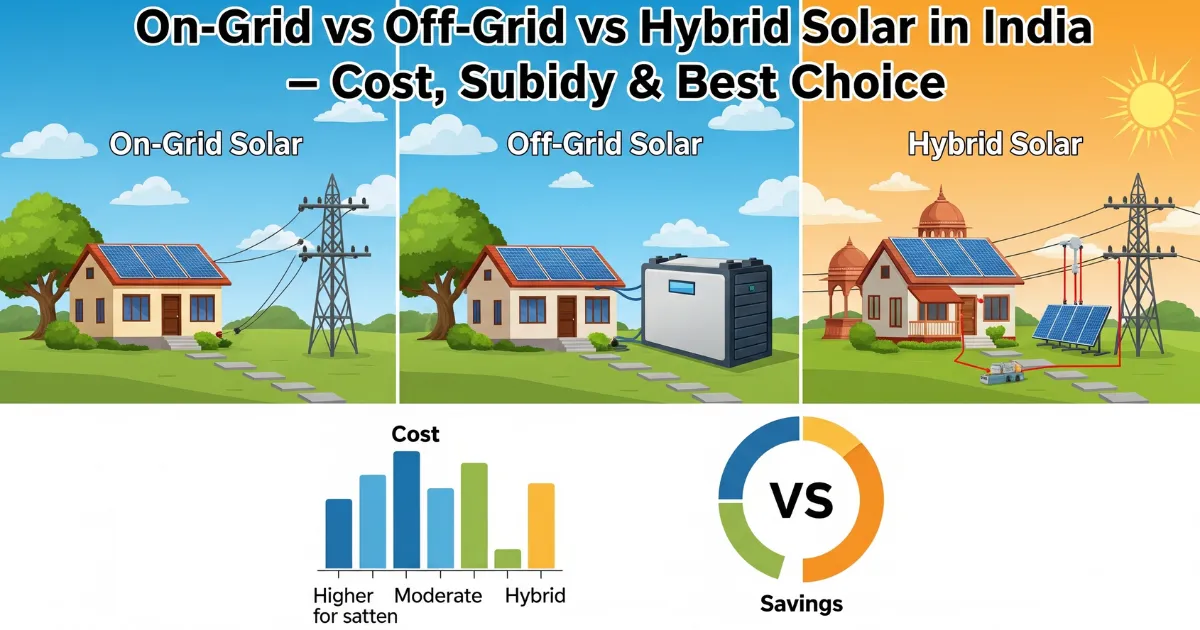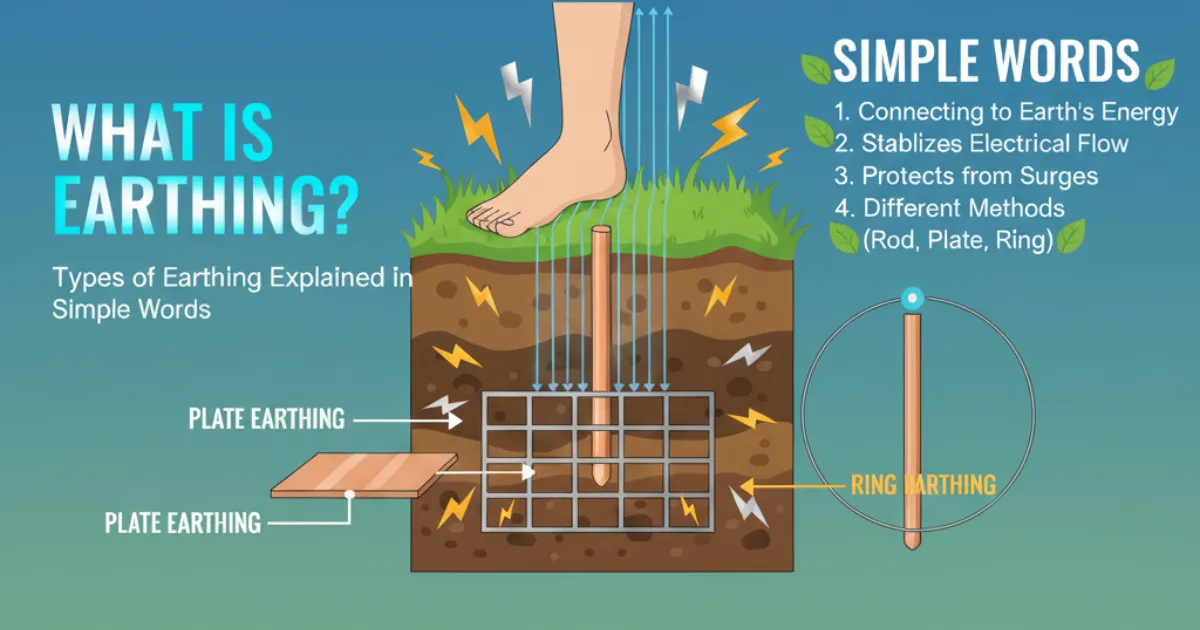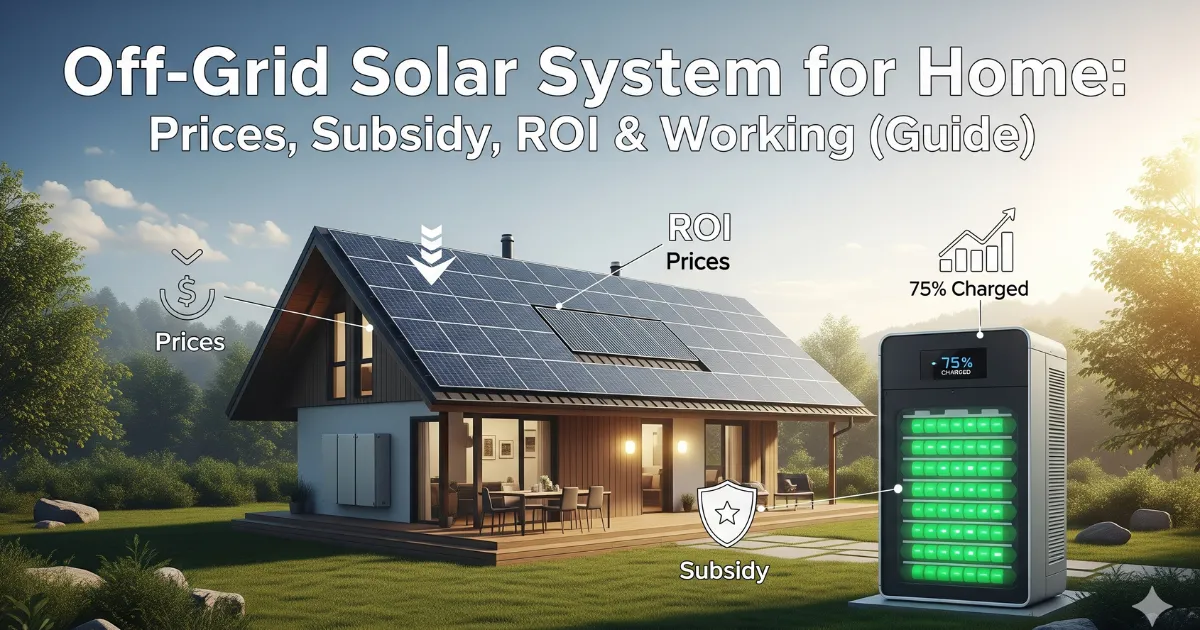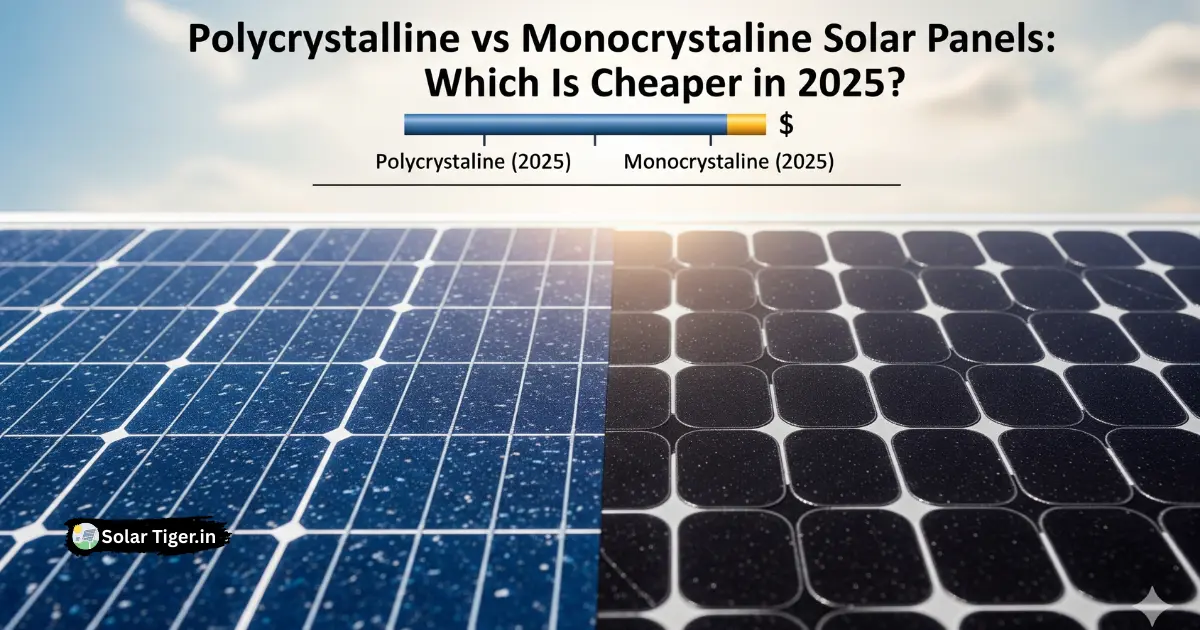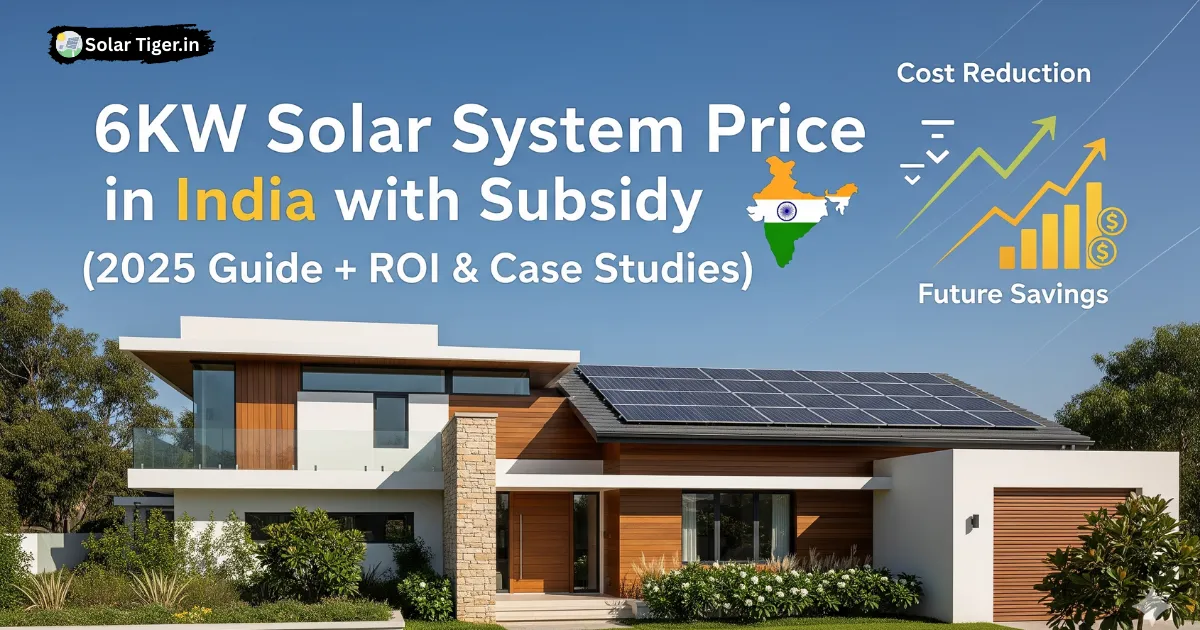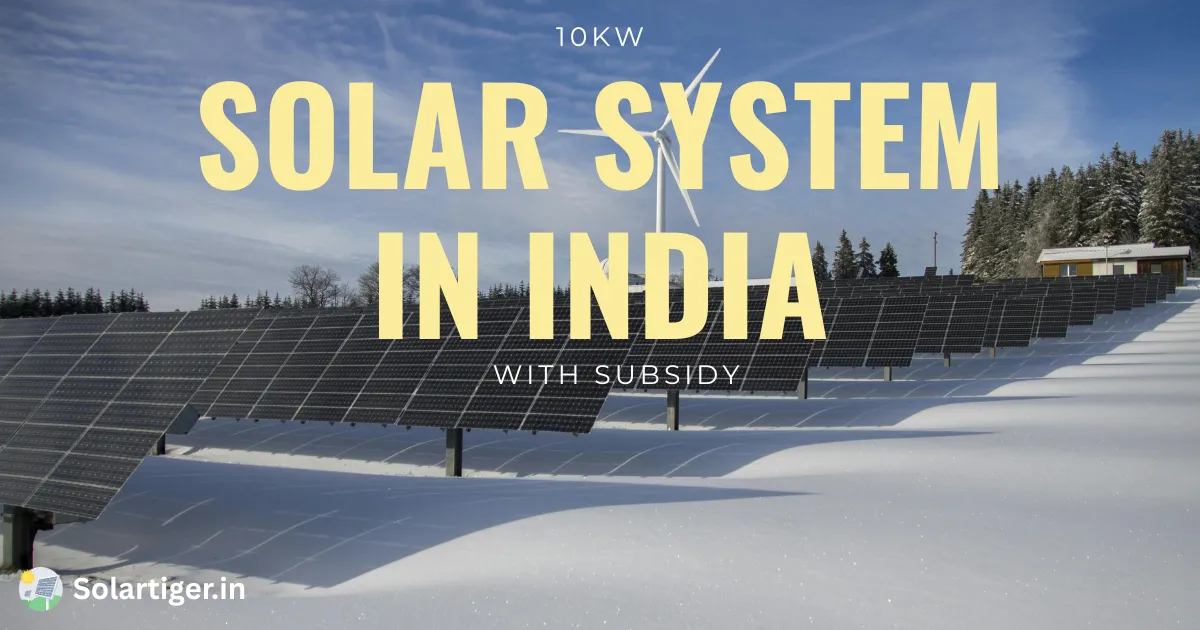Choosing between On-Grid vs Off-Grid vs Hybrid Solar Systems is one of the most common questions Indian homeowners ask when planning rooftop solar. Each option has its own benefits, costs, and limitations On-Grid is known for lower prices and faster ROI, Off-Grid ensures complete independence, and Hybrid gives you the balance of savings plus backup during power cuts. In this guide, we’ll break down the differences with real experiences from Indian households, subsidy updates for 2025, and ROI examples so you can decide which solar system is truly best for your home.
What Are On-Grid vs Off-Grid vs Hybrid Solar Systems?
- On-Grid (Grid-Tied): Connected to the electricity grid. Extra power is exported via net metering. No batteries. Cheapest option.
- Off-Grid: Independent system with batteries. Works without a grid connection. Expensive but essential for remote areas.
- Hybrid: Connected to the grid + has batteries. Offers savings and backup.
Quick Takeaway (Before We Dive Deep)
If you live in cities with reliable power (Delhi, Mumbai, Bengaluru) → On-Grid is cheapest and gives the best ROI.
If you face frequent power cuts (UP, Bihar, Odisha, Kerala during monsoon) → Hybrid is the smarter option.
If you live in a remote area without electricity at all → Off-Grid is your only choice.
For most Indian homes, On-Grid is the best balance of cost and ROI.
1. What Is an On-Grid Solar System?
An on-grid system is directly connected to the electricity grid.
Key Features:
- Works only when the grid is available
- Excess power is exported to the grid through net metering
- No batteries required (lower upfront cost)
- Eligible for government subsidies
Cost in India (2025):
- ₹70,000 – ₹80,000 per kW (before subsidy)
- A 5kW system costs around ₹3.5 – ₹4 lakh, but subsidies can reduce it by 30–40%
Pros:
- Cheaper installation cost
- Low maintenance
- Government subsidy available
- Best ROI (saves electricity bills)
Cons:
- No backup during power cuts
- Fully dependent on the grid
2. What Is an Off-Grid Solar System?
An off-grid system works independently of the power grid. It uses batteries to store solar power for use at night or during outages.
Key Features:
- Works without the grid (ideal for remote areas)
- Requires batteries (increases cost)
- No subsidy available in most states
Cost in India (2025):
- ₹1.2 – ₹1.4 lakh per kW
- A 5kW off-grid system costs around ₹6 – ₹7 lakh
Pros:
- Works during power cuts
- Suitable for villages/remote areas without grid access
- Energy independence
Cons:
- Expensive due to batteries
- Batteries need replacement every 5–7 years
- No subsidy benefits
3. What Is a Hybrid Solar System?
A hybrid solar system combines the best of both worlds. It connects to the grid but also includes a battery backup.
Key Features:
- Uses net metering to export excess electricity
- Stores surplus energy in batteries for backup
- Higher upfront cost but versatile
Cost in India (2025):
- ₹1.1 – ₹1.2 lakh per kW
- A 5kW hybrid system costs ₹5.5 – ₹6 lakh
Pros:
- Power backup during outages
- Savings from net metering
- Eligible for subsidy (on-grid component)
Cons:
- Higher cost than on-grid
- Battery maintenance required
Price Comparison in India (2025 Estimates)
| Solar System Type | Cost per kW (₹) | 5kW System Price (₹) | Subsidy Available? | Ideal For |
|---|---|---|---|---|
| On-Grid | 45,000–55,000 | 2.2–2.7 lakh | ✅ Yes (up to 40%) | Urban households |
| Off-Grid | 65,000–80,000 | 3.2–4.0 lakh | ❌ No subsidy | Villages without electricity |
| Hybrid | 75,000–95,000 | 3.8–4.7 lakh | ✅ Partial subsidy | Semi-urban & outage-prone areas |
ROI & Payback Period
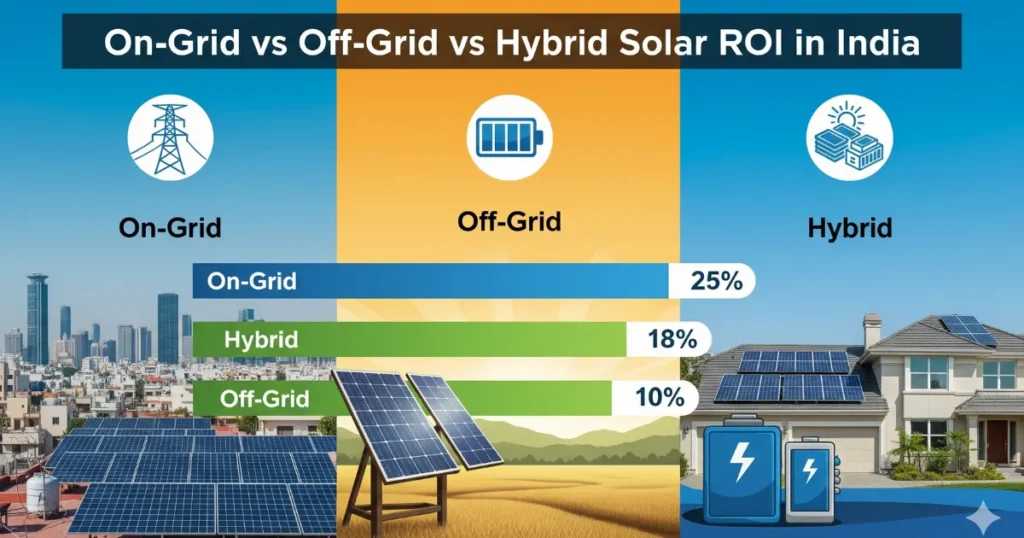
- On-Grid: 4–5 years (fastest recovery).
- Hybrid: 6–7 years (batteries add cost).
- Off-Grid: 7–9 years (no subsidy + costly batteries).
ROI Comparison Table
| System Type | Cost (5kW) | Subsidy | Avg. Bill Savings | ROI Period | Best For |
|---|---|---|---|---|---|
| On-Grid | ₹3.5–4 lakh | 30–40% | ₹5,000–₹6,000/month | 3–4 years | Cities with stable grid |
| Off-Grid | ₹6–7 lakh | No | ₹4,000–₹5,000/month | 5–7 years | Remote/village homes |
| Hybrid | ₹5.5–6 lakh | Partial | ₹5,000–₹6,000/month + backup | 5–6 years | Homes with frequent outages |
Solar Systems Recommendation
- If your main goal is savings, go On-Grid.
- If you want savings + backup, go Hybrid.
- If you need independence, go Off-Grid.
Subsidy Update (2025)
The PM Surya Ghar: Muft Bijli Yojana offers:
- Up to 40% subsidy for systems up to 3kW.
- 20% subsidy for 3kW–10kW.
- Only on On-Grid & Hybrid systems.
- Off-Grid not covered because subsidy doesn’t apply to batteries.
| Details | Resources |
|---|---|
| Official Website | https://pmsuryaghar.gov.in/ |
Which Is Best for Indian Homes?
- Cities (Delhi, Mumbai, Bengaluru): On-Grid → Affordable, ROI in 4–5 years.
- Small towns (Lucknow, Patna, Kochi): Hybrid → Savings + backup.
- Remote villages (Himalayas, deserts, North-East): Off-Grid → Only option.
FAQs
Which solar system is cheapest?
Which gives the best ROI?
Do I get subsidy on batteries?
Can I run ACs on solar?
Which is best for power-cut-prone areas?
Conclusion
If you’re in an Indian city, go On-Grid. If power cuts are frequent, go Hybrid. If there’s no grid at all, go Off-Grid.
Solar is not one-size-fits-all your choice should match your location, budget, and lifestyle.
